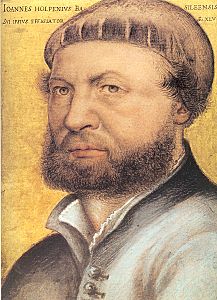
|
Holbein was born in Augsburg. At an early age he began to study painting with his father, Hans Holbein the Elder, a recognized artist in the Flemish tradition who was a skilled portraitist. By 1515 Holbein the Younger had established himself in Basel, Switzerland, as a book illustrator. He designed many title-page woodcuts and completed a series of pen-and-ink sketches for The Praise of Folie by the Dutch scholar Desiderius Erasmus.
During a trip to Italy in 1518, Holbein encountered the works of the Italian Renaissance painters Andrea Mantegna and Leonardo da Vinci. The impact of these and other artists on Holbein's work can be seen in the Renaissance modeling and composition in his early portrait Erasmus of Rotterdam (1523, Musée du Louvre, Paris) and in his renowned Dead Christ and the Passion of Christ (both Kunstmuseum, Basel) and the altarpiece Madonna of Burgomaster Meyer (Grand Ducal Palace, Darmstadt), all completed between 1519 and 1526. In each of these Holbein showed the greater freedom in draftsmanship and the richness of color that characterize the work of the North Italian masters. In his religious works Holbein integrated this wealth of detail and color with the dignity and severity of characterization appropriate to a religious subject.
In the period 1523 to about 1526 Holbein increased his reputation as a book illustrator by a series of 51 drawings portraying the medieval allegorical theme the Dance of Death and by a series of woodcuts for the German translation of the Bible by Martin Luther. Regardless of Holbein's prestige, however, as the austere attitudes of the Reformation further permeated Swiss society, artistic patronage diminished, and he was forced to go to England to gain new commissions. Arriving in 1526 with letters of introduction from Erasmus, now his friend and patron, Holbein was engaged to portray several of the great humanists of the period, including Sir Thomas More.
Returning to Basel in 1528, Holbein was commissioned to make improvements in an earlier work, Justice (1521-1522), with which he had decorated the council chamber of the town hall. His additions to this series of frescoes reflect his continuing growth as an artist; the newer, less crowded compositions convey a still greater dramatic impact than his earlier scenes. Unfortunately, none of Holbein's many great frescoes executed here and in England and Germany have survived intact. Their beauty must be judged, instead, from his sketches and copies of the frescoes made by later artists. Holbein settled again in England in 1532 and began his career as a master portrait painter. His portrait of the statesman Thomas Cromwell brought the artist recognition at court, and by 1536 he was established as court painter to Henry VIII. His most significant works, the portraits of Henry VIII and his wife Jane Seymour, were destroyed by fire in 1698. Several of his portraits of other court figures, including most of Henry VIII's wives and his son Edward (later Edward VI), are still extant. The preliminary drawings for these paintings, in which Holbein combined chalk, silverpoint, pen, and other media, are among his most admired works. A group of 87 drawings is in the royal collection at Windsor Castle. Holbein died in London in 1543 during a plague epidemic.
Holbein's reputation is based on his realistic portrayals of individuals and groups. His attention to every detail of flesh, hair, dress, and ornamentation and his ability to capture their exact texture neither detract from nor betray the basic character and dignity of his subjects. Holbein also contributed many important drawings for the great Renaissance art of glass painting; he also painted miniatures.
|
